ANTIQUE PERSIAN QAJAR BLUE GLASS VASE NASEER AL-DIN SHAH OF QAJAR 19th C
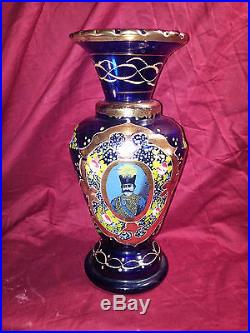
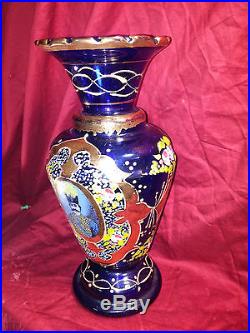
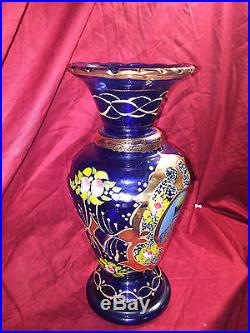
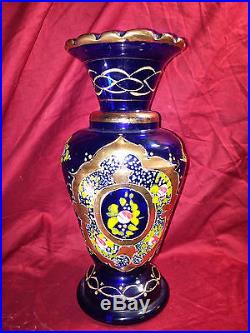
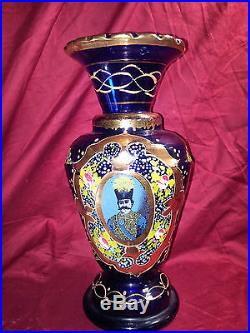
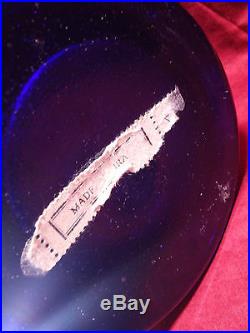

ANTIQUE PERSIAN QAJAR BLUE GLASS VASE WITH IMAGE NASEER AL-DIN SHAH OF QAJAR. Dimension: 11 ¼ inches Condition: Good condition. Qajar art is characterized by an exuberant style and flamboyant use of color, which became more emphatic as the 19th century progressed; here Persian art may be compared with developments in 19th-century Europe, where technological mastery made virtuoso forms of decoration possible.
The Qajar period is now increasingly recognized as a time of significant change in Persian society. Perhaps the most obvious influence was the impact of Western ideas and technology, which accompanied the diplomats, military and technical advisers, merchants, travelers, and missionaries who flocked into 19th-century Persia.
Qajar art, which reflects such influences, has been treated with scant sympathy. Viewed through eyes accustomed to the standards of earlier periods of Persian art, it has been dismissed as garish and unoriginal, instead of being considered on its own terms.
Qajar art is in fact firmly rooted in Persian tradition while giving accurate visual expression to the changes in 19th-century Persia, and any study of it must reflect this duality. A balanced assessment is still difficult because the basic information has not yet been systematically classified: there are no comprehensive indexes of surviving monuments and few catalogues, with the possible exception of paintings. The bibliography is equally meager, as the standard works of Persian art stop with the decline of the Safavids in the early 18th century (as for example, Survey of Persian Art). The most lucid and satisfactory account still is that of Robert Murdoch Smith who, during his career as director of the Persian Telegraph Department from 1865 to 1888 systematically built up collections of Persian art for the Victoria and Albert Museum and viewed Qajar art with a sympathetic yet critical eye R.
Murdoch Smith, Persian Art, London, ca. The priority of Qajar art studies is therefore to catalogue its monuments and artifacts, supplementing firsthand examination and description of this wealth of material with references from secondary sources such as European travel accounts and official reports, Persian chronicles, and archives for example, see A.Sapant, Awqf-e Efahn, Isfahan, 1346. Nasser al-Din Shah Qajar (16 July 1831 1 May 1896) (Persian:) was the King of Persia from 17 September 1848 to 1 May 1896 when he was assassinated. He was the son of Mohammad Shah Qajar and Malek Jahn Khnom and the third longest reigning monarch in Persian history after Shapur II of the Sassanid dynasty and Tahmasp I of the Safavid Dynasty. Nasser al-Din Shah had sovereign power for close to 50 years and was also the first Persian monarch to ever write and publish his diaries.
Naser al-Din was in Tabriz from Qajars tribe when he heard of his father's death in 1848, and he ascended to the Sun Throne with the help of Amir Kabir. Naser al-Din had early reformist tendencies, but was dictatorial in his style of government. With his sanction, some Babis were killed after an attempt on his life. This treatment continued under his prime minister Amir Kabir, who even ordered the execution of the Báb regarded as a manifestation of God to Bábí's and Bahá'ís, and to historians as the founder of the Bábí religion.
Unable to regain territory lost to Russia in the early 19th century, Naser al-Din sought compensation by seizing Hert, Afghanistan, in 1856. Great Britain regarded the move as a threat to British India and declared war on Persia, forcing the return of Hert as well as Persia recognition of the kingdom of Afghanistan. Naser al-Din was the first modern Persian monarch to visit Europe in 1873 and then again in 1878 (when he saw a Royal Navy Fleet Review), and finally in 1889 and was reportedly amazed with the technology he saw. During his visit to the United Kingdom in 1873, Naser al-Din Shah was appointed by Queen Victoria a Knight of the Order of the Garter, the highest English order of chivalry. He was the first Persian monarch to be so honoured. His travel diary of his 1873 trip has been published in several languages as Persian, German, French, and Dutch.1 Toman stamp of 1882. In 1890 Naser al-Din met British Major Gerald F.
Talbot and signed a contract with him giving him the ownership of the Persian tobacco industry, but he later was forced to cancel the contract after Ayatollah Mirza Hassan Shirazi issued a fatwa that made farming, trading, and consuming tobacco haram (forbidden). Consuming tobacco from the newly monopolized'Talbet' company represented foreign exploitation, so for that reason it was deemed immoral. It even affected the Shah's personal life as his wives did not allow him to smoke. Naser al-Din was effective in introducing several different western influences to Persia. He curbed the secular power of the clergy, introduced telegraphy and postal services, built roads, opened the first school offering education along Western lines, and launched Persia's first newspaper.
He was the first Persian to be photographed and was a patron of photography who had himself photographed hundreds of times. His final prime minister was Ali Asghar Khan, who after the shah's assassination aided in securing the transfer of the throne to Mozaffar al-Din.
In 1852 Naser al-Din dismissed and executed Amir Kabir, the famous Persian reformer. With him, many believe, died the prospect of an independent Persia led by meritocracy rather than nepotism. The Shah, on his European tour, in the Royal Albert Hall, London. Seated between the Princess of Wales and her sister, the Tsesarevna of Russia. In the later years of his rule, however, Naser al-Din steadfastly refused to deal with the growing pressures for reforms. He also granted a series of concessionary rights to foreigners in return for large payments that went into his own pockets.In 1872, popular pressure forced him to withdraw one concession involving permission to construct such complexes as railways and irrigation works throughout Persia. This last incident is considered by many authorities to be the origin of modern Iranian nationalism.
Naser al-Din was assassinated by Mirza Reza Kermani, a follower of Jamal al-Din al-Afghani, when he was visiting and praying in the shrine of Shah-Abdol-Azim. It is said that the revolver used to assassinate him was old and rusty, and had he worn a thicker overcoat, or been shot from a longer range, he would have survived the attempt on his life.
[4] Shortly before his death, he is reported to have said I will rule you differently if I survive! Naser al-Din Shah's assassin was prosecuted by the Defence Minister Nazm ol Doleh. Naser al-Din was buried in the Shah-Abdol-Azim shrine, in Rayy near Tehran, where he was assassinated. His one-piece marble tombstone, bearing his full effigy, is now kept in the Golestan Palace Museum in Tehran and is renowned as a masterpiece of Qajar-era sculpture. The Shah in a uniform studded with diamonds from the treasury of the Persian emperors. Often he wore the famous square Darya-ye Noor. Naser al-Din Shah was very interested in painting and photography. He was a talented painter, and even though he had not been trained, was an expert in pen and ink drawing. Several of his pen and ink drawings survive.He was one of the first photographers in Persia and was a patron of the art. He established a photography studio in Golestan Palace. Naser al-Din was also a poet. 200 couplets of his were recorded in the preface of Majma'ul Fusah, a work by Reza-Qoli Khan Hedayat about poets of the Qajar period.
He was interested in history and geography and had many books on these topics in his library. He also knew French and English, but was not fluent in either tongue. Hekyt Pir o Javn (; "The Tale of the Old and the Young") was attributed to him by many; it was one of the first Persian stories written in modern European style. Knight of the Order of the White Eagle of Russia-1838.Grand Cross of the Legion d'Honneur of France-1855. Grand Cross of the Order of Saint Stephen of Hungary-1859. Grand Cross of the Order of Saints Maurice and Lazarus of Italy-1862.
Knight of the Order of the Most Holy Annunciation of Italy-1862. Grand Cross of the Order of the Netherlands Lion-1868. Knight of the Order of St.Knight of the Order of Saint Stanislaus, 1st Class of Russia-1873. Anna, 1st Class of Russia-1873. Knight of the Order of the Garter (KG)-1873.
Knight of the Order of the Black Eagle of Prussia-1873. Grand Cross of the Order of the Red Eagle of Prussia-1873.Grand Cordon of the Order of Leopold of Belgium-1873. Exalted Order of Honour of Turkey-1880. Mozaffar al-Din Shah Qajar Enthroned, One of 274 Vintage Photographs - Antoin Sevruguin.
Prince Soltan Mahmoud Mirza (18471849) Vali Ahad of Persia, 1849. Prince Soltan Moin ed-Din Mirza (1849 6 November 1856) Vali Ahad of Persia, 184956. Prince Soltan Massoud Mirza Zell os-Soltan (5 January 1850 2 July 1918). Prince Mohammad-Qassem Mirza (1850 29 June 1858) Vali Ahad of Persia, 1856-8.
Prince Soltan Hossein Mirza Jalal od-Dowleh (18521868) [8]. Prince Mozaffar ed-Din Mirza (25 March 1853 7 January 1907). Prince Kamran Mirza Nayeb os-Saltaneh (22 July 1856 1927).
Prince Nosrat ed-Din Mirza Salar os-Saltaneh (2 May 1882 1954). Prince Mohammad-Reza Mirza Rokn os-Saltaneh (30 January 1884 8 July 1951).
Prince Hossein-Ali Mirza Yamin od-Dowleh (18901952). Prince Ahmad Mirza Azd os-Saltaneh (18911939). Princess Fakhr ol-Moluk (1847 9 April 1878). Princess Esmat od-Dowleh (1855 3 September 1905). Princess Zi'a os-Saltaneh (1856 11 April 1898) [9]. Princess Farah os-Saltaneh (1882 17 April 1899). Princess Tadj os-Saltaneh (1883 25 January 1936).Princess Ezz os-Saltaneh (18881982)[10]. Mirza Taqi Khan Amir Kabir (1848 1851). Mirza Aqa Khan-e Nuri (1851 1858).
Mirza Hosein Khan Moshir od-Dowleh Sepahsalar (1871 1873). Mirza Yousof Khan Ashtiani (1873 1880) (1st time). Prince Kamran Mirza (1880 1885). Mirza Yousof Khan Ashtiani (18851887) (2nd time).
Mirza Ali-Asghar Khan Amin os-Soltan (1887 1896) (1st time). The item "ANTIQUE PERSIAN QAJAR BLUE GLASS VASE NASEER AL-DIN SHAH OF QAJAR 19th C" is in sale since Friday, August 07, 2015.
This item is in the category "Antiques\Asian Antiques\Middle East". The seller is "adamodenni" and is located in Bellmore, New York. This item can be shipped worldwide.
- Color: Blue
- Type: Vases
- Primary Material: Glass
- Age: 1850-1899
- Region of Origin: Unknown
- Original/Reproduction: Original
